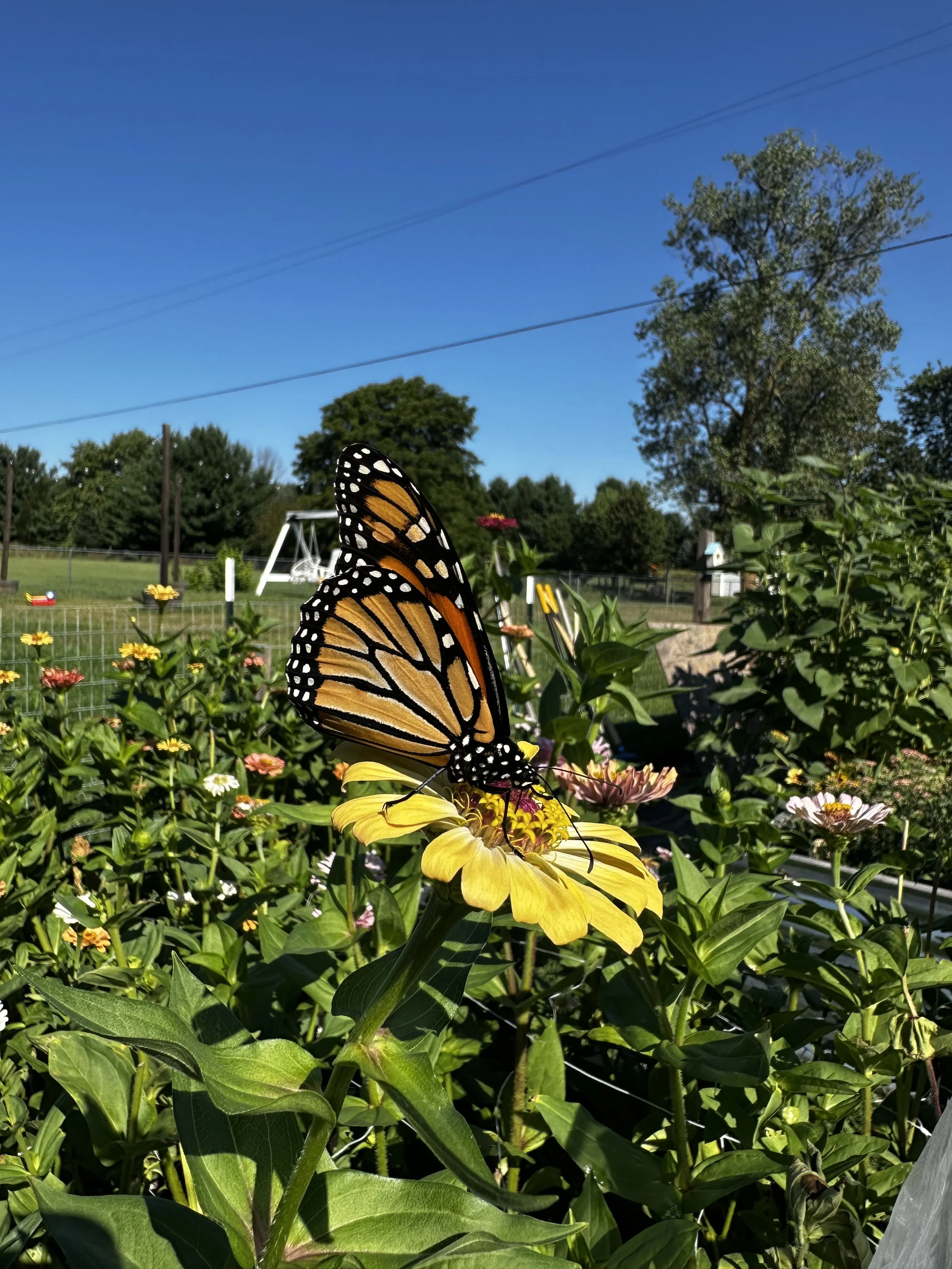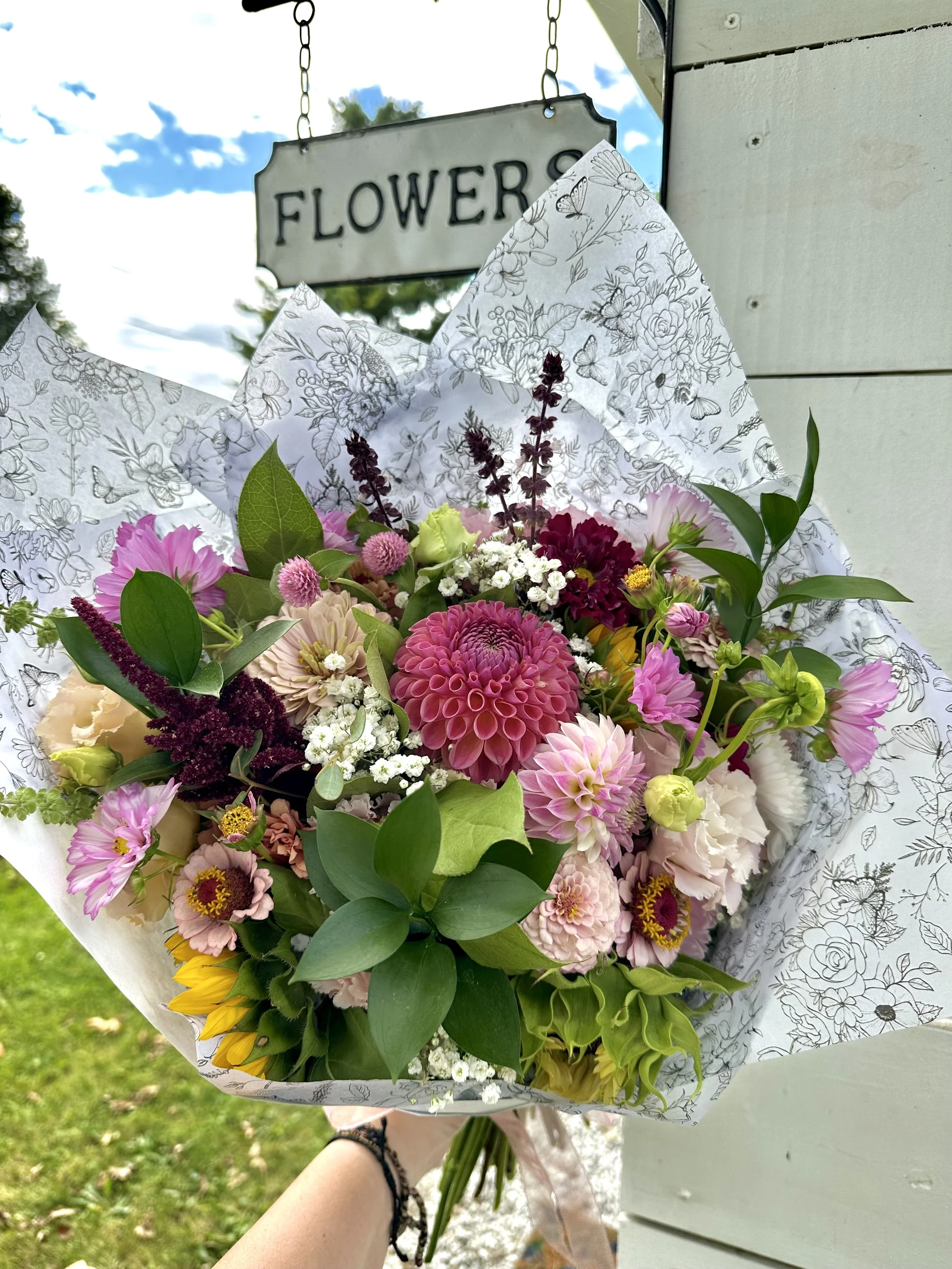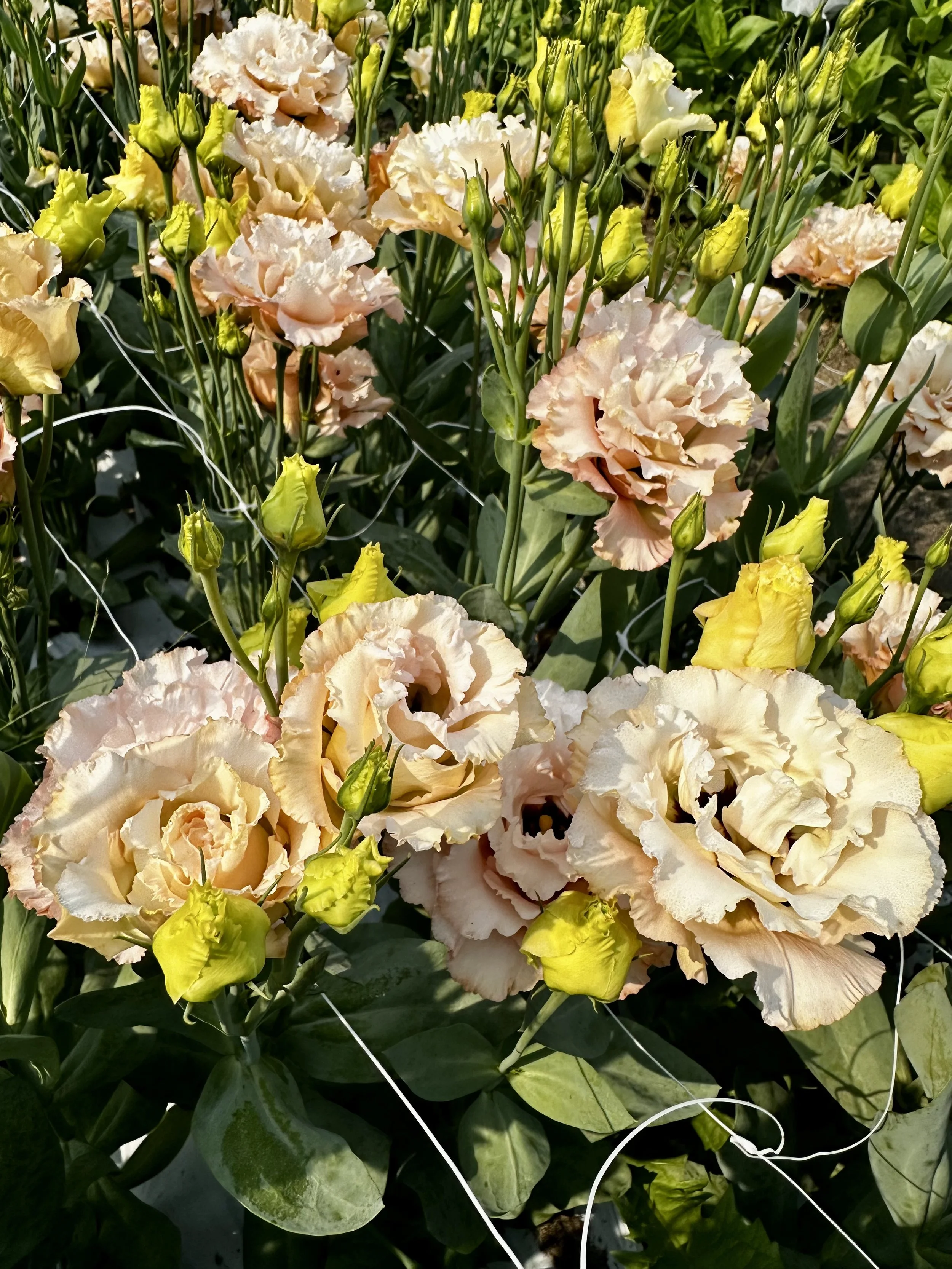Flower Farm Troubleshooting: Common Garden Pests & How We Naturally Combat Them
Before I dive in, I want to preface that I am always learning and adapting in this flower farming journey. These methods are simply what’s worked for us so far here at Bede’s Blooms — I’m continually experimenting, tweaking, and discovering new approaches along the way. My hope is to share what I’ve learned to help others while reminding myself that this is a process of growth, not perfection.
If you’ve ever walked out to your flower beds only to find chewed leaves, sticky stems, or blooms riddled with holes—you’re not alone. Mid-summer brings a surge in pest pressure, and flowers can be just as vulnerable as vegetables when it comes to unwanted visitors.
Here on our little patch of soil at Bede’s Blooms, we grow as organically and naturally as possible. That means paying close attention to what’s showing up—and responding in a way that protects pollinators, supports long-term soil health, and keeps our blooms beautiful.
Here are some of the most common flower garden pests we face (and how we manage them without harsh chemicals):
🪲 1. Japanese Beetles
What they do: Skeletonize leaves, chew through petals (especially on roses, dahlias, zinnias, and sunflowers).
Signs: Metallic green beetles in groups, chewed leaves with only the veins remaining. Peak season here in Michigan is July.
How we combat them:
Hand-pick early morning when they’re sluggish (drop into soapy water).
Use Neem oil spray weekly in the evening (avoid spraying blooms to protect bees).
Trap crops like sacrificial grapes, evening primrose, white geraniums or borage planted at the edge of the garden can help lure them away.
We also build resilience from below: applying beneficial soil spores and releasing nematodes from Natures Good Guys into the soil, which target beetle larvae before they ever emerge as adults.
Use code BEDESBLOOMS for a 20% discount!
🐛 2. Caterpillars & Cutworms
What they do: Munch on leaves and flower buds overnight, cut seedlings at the base.
Signs: Ragged leaves, severed stems, droppings on foliage. Cutworms are usually worst in spring right after transplanting, while caterpillar pressure can flare up mid-to-late summer depending on the moth cycles in our area.
How we combat them:
Apply BT (Bacillus thuringiensis) — a natural bacterial spray that targets caterpillars but won’t harm bees or humans.
Use collars around seedlings to deter cutworms at transplant time.
Introduce beneficial insects like Trichogramma wasps (we source ours from Nature’s Good Guys) — they’re tiny, non-stinging wasps that lay their eggs inside moth eggs, stopping caterpillars before they even hatch.
Invite birds and other natural predators by planting habitat hedgerows nearby.
🪰 3. Aphids
What they do: Suck sap from tender stems and buds, causing distortion and stunting. They tend to build up quickly in late spring and early summer when tender new growth is abundant, but can flare again in fall on cool-season flowers.
Signs: Clusters of soft-bodied insects on new growth, sticky “honeydew” residue, ants farming them.
How we combat them:
Blast off with a strong stream of water on infected plants.
Spray with a homemade insecticidal soap (1 tsp castile soap + 1 quart water).
Release or attract ladybugs and lacewings, natural aphid predators. (Also sourced from Natures Good Guys!)
🐜 4. Thrips
What they do: Damage petals, cause streaking and browning in delicate blooms like lisianthus, snapdragons, and cosmos.
Signs: Blooms fail to open, petals have silvery streaks or brown edges. Thrips pressure is highest during hot, dry stretches of summer — we see the most damage here in July and August.
How we combat them:
Use blue or yellow sticky traps to monitor and reduce populations.
Spray with Neem + insecticidal soap combo (avoid spraying when bees are active).
Encourage diverse companion planting (basil, marigolds, dill) to confuse and deter them.
🪳 5. Earwigs
What they do: Feed at night, chewing irregular holes in petals and leaves. They’re most noticeable in midsummer when the weather is warm and damp, especially if mulch layers stay moist.
Signs: Holes in dahlia petals, hiding under mulch or flower heads.
How we combat them:
Set out rolled-up damp newspaper traps at night and discard in the morning.
Trap trick: In the evening, roll up a few sheets of damp newspaper or cardboard and tuck them near the base of your plants. Earwigs will crawl inside overnight to hide. In the morning, simply pick up the rolls, shake them into a bucket of soapy water, and discard the insects. Reset fresh traps each evening as needed.
Tidy up mulch layers and avoid overwatering which attracts them.
Sprinkle diatomaceous earth (food-grade) around the base of plants (reapply after rain).
Diatomaceous earth (often called DE) can be used as a natural pest control method in the garden. When sprinkled around the base of plants, it creates a barrier against pests like slugs, beetles, and ants. The fine powder works by scratching the outer layer of an insect’s exoskeleton, which causes them to dry out.
It’s important to note, though, that not all DE is created equal. Always choose food-grade or feed-grade DE labeled safe for organic use, and never use pool-grade DE—that type contains crystalline silica, which is harmful if inhaled.
A few safety notes from our own practice:
Apply sparingly, and reapply after rain.
Wear a mask when applying, since even food-grade DE can irritate your lungs if inhaled.
Be mindful that DE doesn’t distinguish between pests and beneficial insects—it can affect both.
We personally use DE cautiously, only in specific situations where pests are really troublesome. It’s a helpful tool, but not one I reach for first since I want to protect the beneficial bugs that keep our garden in balance.
This handy applicator with a tip is another great choice for simple, precise use.
🐌 6. Slugs & Snails
What they do: Leave large holes in foliage, especially damaging to seedlings and low-growing plants like dahlias, zinnias, and pansies.
Signs: Slimy trails, ragged leaf holes, and damage that appears overnight. They’re especially bad in spring when conditions are cool and damp.
How we combat them:
Beer traps – A classic trick that actually works. Bury a shallow dish (like a tuna can, Tupperware container or jar lid) so the rim is level with the soil surface. Fill with beer and check in the morning. Slugs are drawn to the yeast, fall in, and can’t escape.
Crushed eggshells or coffee grounds – These create a rough barrier around plants that slugs avoid crawling over.
Copper tape – Acts like an electric fence for slugs. You can place it around containers or bed edges.
Water in the morning – Slugs thrive in damp, cool conditions. Watering early allows surfaces to dry by nightfall, reducing habitat.
7. Grasshoppers: 🦗
What they do: Grasshoppers chew through tender seedlings and foliage, sometimes wiping out entire plantings overnight. They especially target young cosmos, zinnias, sunflowers, and tender vegetable crops. During heavy infestations, they’ll eat nearly anything, though tomatoes tend to be less preferred. We tend to see the worst damage in late summer when populations surge. Last year, they mowed my poor cosmos down to the ground in a single night — lesson learned!
Signs: Ragged, chewed leaves, seedlings eaten down to the soil line, and adult hoppers leaping or flying up when you walk through the garden.
How we combat them:
Hand capture & smash: The simplest method — when you spot them, catch and crush them before they can multiply.
Row cover protection over seedlings until plants are strong enough to handle some feeding.
Trap crops such as tall grasses, rye, or wheat along the garden edges to lure them away from your beds.
Encourage natural predators like birds, beneficial insects (like robber flies), and even chickens or ducks. Free-range poultry are particularly fond of grasshoppers.
Soil-level defense: Applying beneficial nematodes and microbial spores helps reduce the number of overwintering eggs that hatch into destructive nymphs.
Those seven are our biggest culprits here at Bede’s Blooms + Co., but over time I’ve realized that pests aren’t just something to fight off — they’re part of a bigger garden ecosystem. That shift in perspective is what shapes how we approach pest control overall.
🌿 Our Pest Philosophy: Work With Nature
We don’t aim to eliminate every bug in the garden. Instead, we focus on balance—and beneficial insects are our secret allies in the fight.
🐞 The Good Guys: Beneficial Insects We Use
We regularly release and nurture beneficial insects that target the very pests we’re trying to manage. These tiny farm allies are safe for pollinators, pets, and children—and they play a huge role in maintaining a thriving, biodiverse flower ecosystem here at Bede’s Blooms.
🌱 Where We Source:
We source most of our beneficial insects from Nature’s Good Guys—a trusted, family-run company specializing in sustainable pest management. They offer everything from ladybugs to lacewings and even Trichogramma wasp eggs, which help control caterpillars before they hatch. I love supporting companies that share the same commitment to ecological balance and education.
If you’d like to try beneficial insects in your own garden, Nature’s Good Guys has kindly shared a 20% discount code: BEDEBLOOMS20 — a small thank-you for supporting pollinator-safe, sustainable growing practices.
1. Beneficial Nematodes (Steinernema feltiae & Heterorhabditis)
We use several types of beneficial nematodes in our soil — they’re microscopic roundworms that attack pest larvae underground before they can cause damage aboveground. Each variety has its own specialty, which is why we layer them for broader protection.
👉 Quick Guide: Which nematode targets which pest?
Steinernema feltiae → Fungus gnat larvae, cutworms, thrips pupae, root weevils
Steinernema carpocapsae → Armyworms, sod webworms, caterpillars, surface grubs
Heterorhabditis bacteriophora → Japanese beetle grubs, June beetles, other root-feeding beetle larvae
How we apply them:
Use hose-end sprayer packs and apply early morning or evening.
Apply after a rainfall or light watering (soil must be moist).
Soil temps between 45–85°F are best.
Avoid applying in full sun (UV light can kill them).
For best results, apply in spring and again in late summer to match larval cycles in the soil.
💡 Tip: Rotate or layer different nematode species throughout the season to cover more pests — one application rarely solves it all.
2. Ladybugs: Tiny Allies with a Big Job
Targets: aphids, spider mites, thrips, mealybugs, whiteflies, and more.
We like to release them in the evening after lightly misting the plants—this helps them settle in and stick around. It’s honestly magical to watch them march straight into an aphid colony and get to work!
One of my favorite garden helpers is the convergent ladybug (Hippodamia convergens)—a species native to the U.S. and a true little warrior. These aren’t just pretty beetles with spots; they’re hardworking protectors of our flowers, vegetables, and greens.
We’ve had great success using pre-fed ladybugs from our beneficial insect supplier (they like to call them Soldier Bugs - I love that!). They adapt beautifully in all kinds of environments—whether it’s an outdoor bed, greenhouse, or even patio containers. With food and water, adults can live for weeks (sometimes months), and by reintroducing them a few times throughout the season, you can stay a step ahead of the pest cycle naturally.
Why Use Ladybugs?
Natural-born predators: Both larvae and adults feast on soft-bodied pests like aphids, mites, and whiteflies.
Hands-off help: Once released, they go right to work hunting down plant-damaging insects.
Eco-friendly: Skip the chemical sprays and support a healthier ecosystem.
Bigger harvests: Stronger plants mean more blooms and produce.
Safe & sustainable: People, pets, pollinators, and the planet all benefit.
3. Green Lacewings
Targets: Aphids, thrips, mealybugs, small caterpillars.
We order them as eggs or larvae and apply them directly into problem areas or onto foliage. They’re tiny but incredibly efficient predators.
4. Praying Mantis
Targets: Any insect in their path (including pest caterpillars).
These are generalist predators—we raise them from egg cases (oothecae) and place them throughout the farm. They grow slowly but become majestic guards of the garden.
🐝 A Final Note on Timing + Spray Safety
Always:
Spray in the early morning or evening
Avoid spraying blooms to protect pollinators
Observe and identify before acting—sometimes it’s a beneficial bug, not a bad one!
🧺 Tools We Keep on Hand:
Soapy water buckets + gloves (I use these through the cold months too, they’re amazing)
Beneficial insects + nematodes
Organza Bags to cover blooms like dahlias
🌼 Conclusion: It’s All About Balance
In a healthy, diverse garden, not every bug is a villain — and not every hole in a leaf is a crisis. By observing closely, leaning on natural allies, and working with the ecosystem instead of against it, your flowers can thrive through the summer surge of pests without ever needing harsh sprays.
Let your garden be a little wild, a little balanced, and a whole lot beautiful.
What about you? 🌿 Which pests give you the most trouble, and what natural tricks have you found that work best in your garden? I’d love to hear your tried-and-true remedies.
With blooms & balance,
Alex 🌼
















